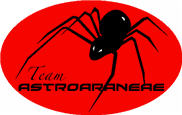 Over at The Space Elevator Reference, Dr. Bradley Edwards gives us his thoughts on designing the optimal climber. This is a fine, detailed analysis with lots of practical information.
Over at The Space Elevator Reference, Dr. Bradley Edwards gives us his thoughts on designing the optimal climber. This is a fine, detailed analysis with lots of practical information.
Daily Archives: October 10, 2006
10 Days and Counting!
 Only 10 more days until the start of the Space Elevator Games. I’m not associated with any of the Climber or Tether teams, but I can imagine the frantic pace they’re working at now to finalize their entries.
Only 10 more days until the start of the Space Elevator Games. I’m not associated with any of the Climber or Tether teams, but I can imagine the frantic pace they’re working at now to finalize their entries.
The Climber competition seems to get most of the attention and there’s no doubt that it will be visually very appealing – watching each team’s entry as it attempts to climb faster and with more weight than their competitors. But I think the tether competition is going to be very interesting, too. As Michael Remington of Team Astroaraneae puts it “The tether competition will be head-to-head, while the lifter competition is essentially a time-trial.” As of now, there are three tether competitors who definitely will be there and two more who may or may not make it.
In the tether competition, two tethers will be mounted on a pulling mechanism. The pulling mechanism will do its thing while the tethers will be trying to stay in one piece. The scoring mechanism is essentially a measuring and lockout circuit; it will measure when one of the tethers breaks or stretches more than allowed. When this happens, a signal will be sent to light up a lamp signifying the winner (the other tether, of course), while the lockout circuit will prevent the winning tether from lighting up the other lamp. Matches are best two out of three. Tethers may weigh no more than two grams.
 A two-gram “House tether” may be used as one of the competitors in order to create evenly numbered brackets. This depends on how many competitors show up. If there are four entries (a distinct possibility), they’ll be divided into two brackets of two each to compete, with the two winners competing against each other for the right to compete for a chance to win the prize.
A two-gram “House tether” may be used as one of the competitors in order to create evenly numbered brackets. This depends on how many competitors show up. If there are four entries (a distinct possibility), they’ll be divided into two brackets of two each to compete, with the two winners competing against each other for the right to compete for a chance to win the prize.
Once a head-to-head winner has been declared, it will be matched against a three-gram House tether. If it can beat this tether, then it will be awarded the $200,000.00 Prize money. As the House tether will weigh 50% more than the competitors tether (three grams vs. two grams), this means that the competitors tether must be 50% stronger than the House tether to win the prize.
 The plan is to increase the strength requirements each year (as well as including new requirements when appropriate). Teams know this; Patrick Littlejohn of Team Snowstar states; “The Snowstar Tether group has been working since January 2006, with an emphasis on extensive testing in order to get the best results out of conventional materials. As the competition progresses through 2010, we hope to incorporate more and more next gen materials into our research and development until one day a working elevator is a reality. If we win, we will be throwing one hell of a party.”
The plan is to increase the strength requirements each year (as well as including new requirements when appropriate). Teams know this; Patrick Littlejohn of Team Snowstar states; “The Snowstar Tether group has been working since January 2006, with an emphasis on extensive testing in order to get the best results out of conventional materials. As the competition progresses through 2010, we hope to incorporate more and more next gen materials into our research and development until one day a working elevator is a reality. If we win, we will be throwing one hell of a party.”
The official tether competition rules can be found here and this year’s tether entrants can be found here.
